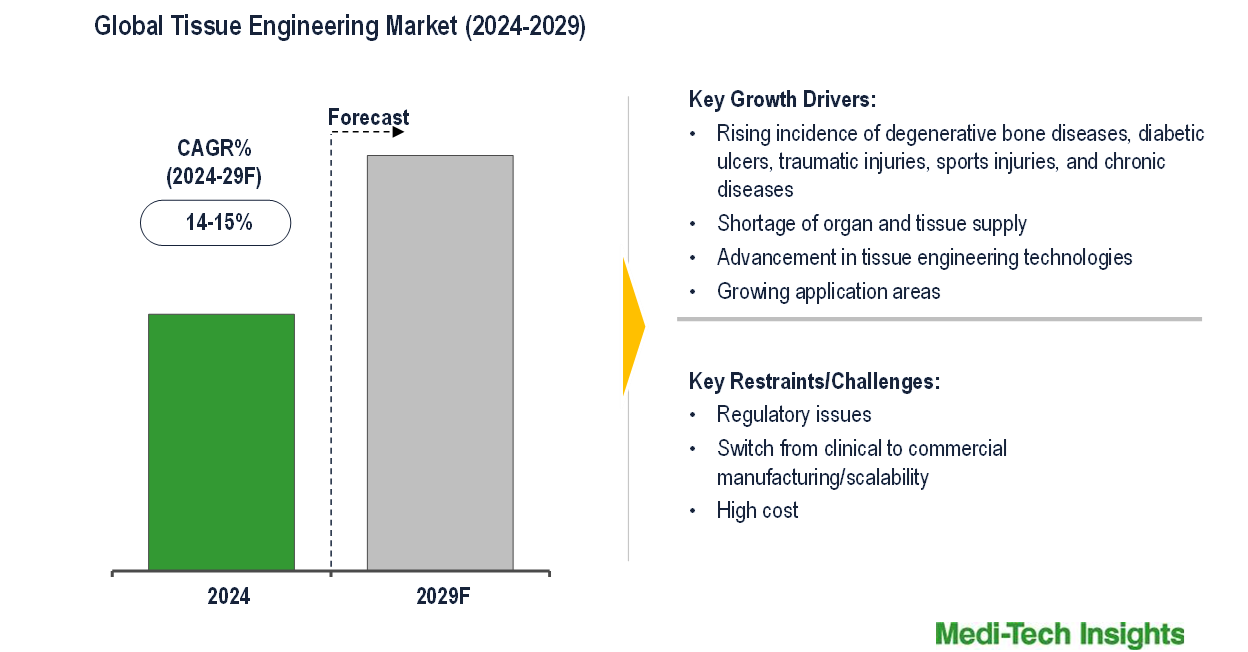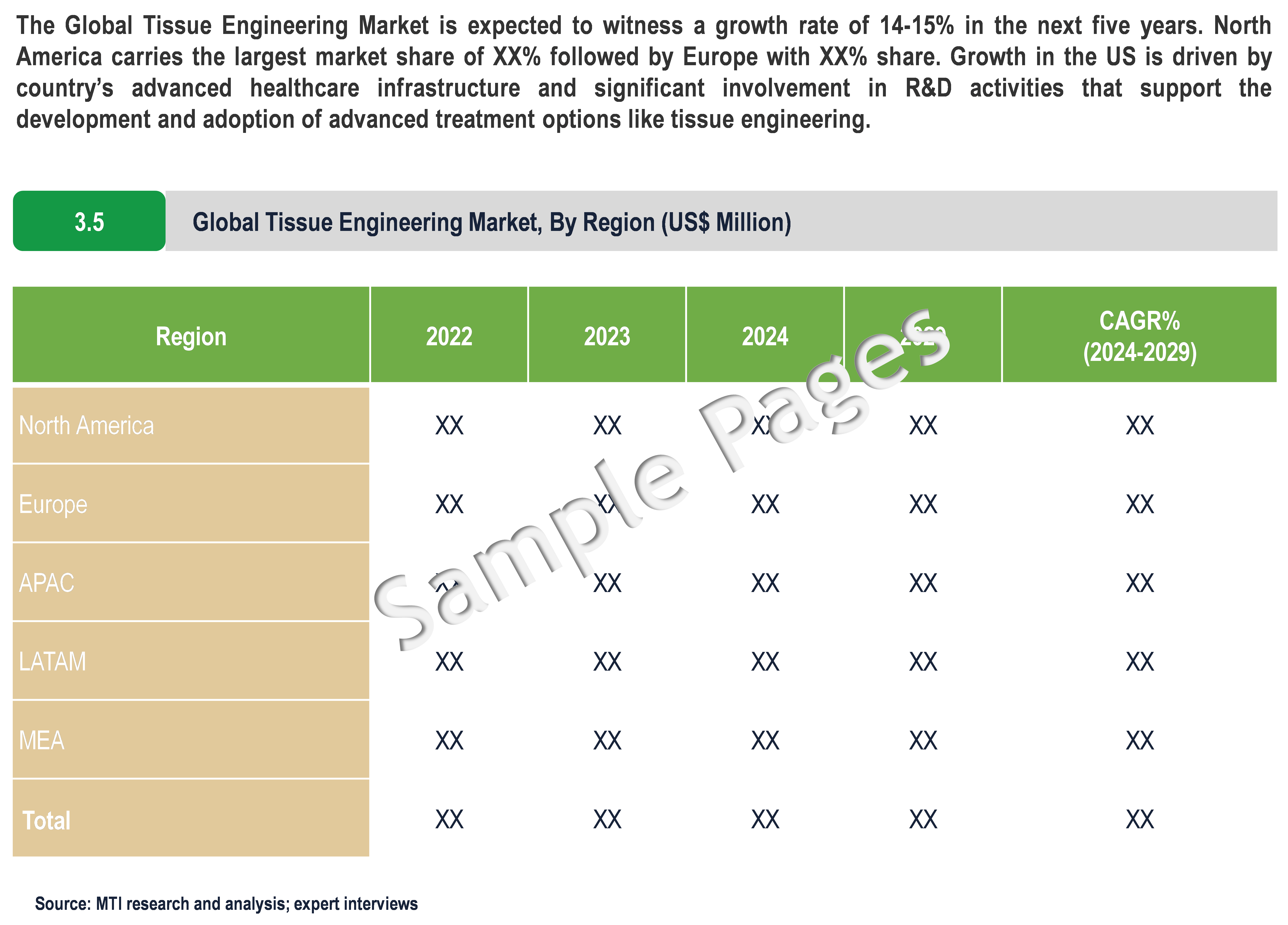
Tissue Engineering Market Size, Growth Drivers, Trends, Future Challenges, and Forecasts 2024 to 2029
The Global Tissue Engineering Market is expected to witness a growth rate of 14-15% in the next five years. Rising incidence of degenerative bone diseases, diabetic ulcers, traumatic injuries, sports injuries, and chronic diseases; shortage of organ and tissue supply; and advancement in tissue engineering technologies such as 3D printing, use of smart biomaterials, induced pluripotent stem cells (iPSCs), and microfluidics are some of the key factors fostering tissue engineering market growth. However, clinical translation of tissue-engineered products is challenging largely due to factors such as scalability, cost, and regulatory issues that are likely to hinder market growth. To learn more about the research report, download a sample report.
Tissue and organs may lose their function and structure due to age, diseases, trauma, surgical removal, and congenital defects. Tissue engineering combines cells, scaffolds, and growth factors to regenerate tissues or replace damaged or diseased tissues. This can be achieved either ex vivo or in situ by using various molecules, materials, or cells to stimulate local tissue regenerative capacity. Tissue engineering is increasingly gaining traction in the medical field with the growing need to restore, maintain, or improve damaged tissues or whole organs.
Shortage of Organs and Tissues to Drive Market Growth
With the intensifying aging of the world population, there is an increasing demand for organ replacements. Kidneys are the most frequently transplanted organ and help patients with end-stage kidney disease. Some other frequently transplanted organs include livers, lungs, and hearts. While organ transplantation is increasingly used as medical treatment, a shortage of organs is a major concern. Many patients die every day while waiting for a transplant due to the shortages in organ and tissue supply. For instance, 5600 people in the US die each year while on the transplant waiting list (Donate Life America); and in 2022, an average of 19 patients died every day while waiting for an organ transplant in Europe (EU Commission). This shortage of organs, tissues, and cells has boosted the development and demand for tissue engineering as it aims at producing functional tissue constructs for use in the reconstruction or regeneration of damaged or lost tissues and organs.
Orthopedics and Musculoskeletal Disorders – A Major Application Area of Tissue Engineering
Application areas of tissue engineering include orthopedics & musculoskeletal disorders, cardiovascular diseases, dental & maxillofacial disorders, dermatology & wound care, neurology, and among others. Currently, tissue-engineered products are significantly used in orthopedics and musculoskeletal disorders to address bone regeneration and repair clinical needs. As musculoskeletal disorders are most prevalent in the elderly, the world’s aging population represents the major contributing factor to the increasing medical and socioeconomic burdens of treating musculoskeletal impairments. Approximately, 1.71 billion people have musculoskeletal conditions worldwide (WHO). Tissue engineering is a promising strategy for structural support for new bone formation. With the growing burden of orthopedic and musculoskeletal injuries and the availability of advanced tissue-engineered products, the demand for tissue engineering is likely to further propel the market growth.
“Tissue engineering has widespread applications in bone, periodontal tissue defects, skin repairs, and corneal transplantation. However, with technological advancements and growing research in this field, we see tremendous progress in the use of tissue engineering in areas such as neuroscience and cardiovascular in the future.”
"- Manager of Marketing & Business Development, A Leading Tissue Engineering Company, United States
To learn more about this report, download the PDF brochure
Trend Towards 3D Printing
The field of tissue engineering continues to evolve with recent developments in processing techniques. Some of the conventional techniques that have been used to develop scaffolds, matrices, or tissue constructs include salt leaching, molding, spinning, freeze-drying, solvent casting and particulate leaching, electrospinning, and selective laser sintering. However, recently 3D printing has been gaining increasing popularity owing to several advantages over other tissue engineering techniques including the creation of well-defined, customized structures that mimic native tissues, and cost-effectiveness, among others. Different combinations of various fabrication techniques are being used such as combining electrospinning with 3D bioprinting to produce advanced scaffolds.
US Expected to be a Major Growth Engine in the Tissue Engineering Market
The US is expected to be a major growth engine in the tissue engineering market due to several key factors. The country’s advanced healthcare infrastructure and significant involvement in research and development activities support the development and adoption of advanced treatment options like tissue engineering. The US also faces a significant burden of an aging population and chronic diseases, driving demand for solutions that improve patient health and reduce healthcare costs. Moreover, the US has a presence of big companies involved in tissue engineering such as Integra Lifesciences, J&J Services, NuVasive, Stryker, and BioTissue, among others, further improving product availability and growth.
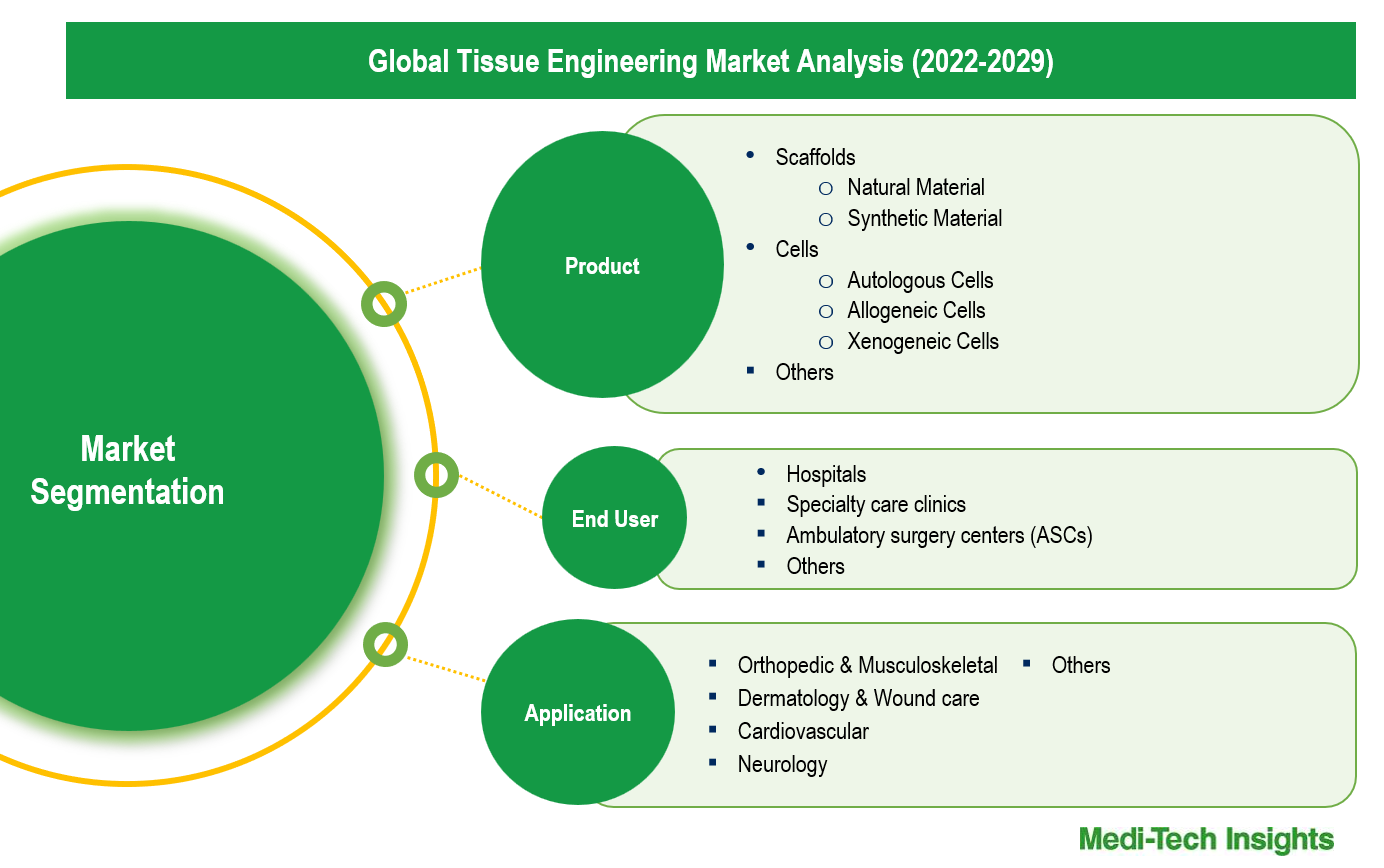
To learn more about this report, download the PDF brochure
Product Type Segment Analysis
The tissue engineering market comprises cells, scaffolds, and other products. Tissue engineering often begins with a scaffold, which may utilize material from naturally occurring proteins to biocompatible synthetic polymers. Scaffolds are the largest product segment wherein the use of Synthetic Materials is greater as compared to Natural Materials. On the other hand, Cells form the basis of tissue engineering. Depending on the application, cells can be derived from various sources such as Autologous Cells (derived from the same individual), Allogeneic Cells (sourced from a donor of the same species), and Xenogeneic Cells (obtained from a different species, typically used for research).
End-user Type Segment Analysis
The tissue engineering market can be analyzed based on end-user types, such as Hospitals, Ambulatory Surgery Centers (ASCs), Specialty Care Clinics, and Others. Hospitals represent the largest segment as they are well-equipped to handle the complexity of patient care and manage high patient volumes. However, specialty care clinics and ASC segments are likely to witness faster growth driven by the growing number of ASCs and increasing procedures performed at these centers.
Organic and Inorganic Growth Strategies Adopted by Players to Establish Their Foothold in the Market
Players operating in this market are adopting both organic and inorganic growth strategies such as collaborations, acquisitions, and new product launches to garner market share. For instance,
- In July 2024, MiMedx Group, Inc. launched HELIOGEN™ Fibrillar Collagen Matrix, a particulate xenograft product aimed at addressing complex wounds primarily in the surgical setting. HELIOGEN is a shelf-stable offering that contains Type I and Type III collagen and mimics the native composition of structural connective tissue
- In January 2024, Cellular Logistics Inc. and Allele Biotechnology Inc. collaborated to develop regenerative medicine products to treat ischemic heart disease. Cellular Logistics’ SolusTM, is a highly promising formulation of a regenerative medicine biomaterial designed to minimize injury and revitalize damaged heart tissue for patients suffering a heart attack. Clinical development of SolusTM will utilize ALLELE’s GMP-grade iPSC lines embodying the company’s IP-protected mRNA-based cell reprogramming technology
- In January 2023, BioMed X and AbbVie extended research collaboration in the US focused on the development of a new tissue engineering platform to produce complex human ex vivo models (disease-on-a-chip) from primary human cells and tissues to study human tissue inflammation
The tissue engineering market is expected to gain further momentum in the coming years due to technological advancements, rising R&D investments, and aggressive organic and inorganic growth strategies followed by the players.
Competitive Landscape Analysis
The global Tissue Engineering market is marked by the presence of established and emerging market players such as Integra LifeSciences Corporation, Medtronic, AbbVie, BioTissue, NuVasive, J&J Services, Organogenesis, Stryker, Terumo, Matricel (Nobel Biocare), Regrow Biosciences, Mallinckrodt Pharmaceuticals, Sumitomo Pharma, CollPlant Biotechnologies, Mimedx, Smith+Nephew, Cellular Logistics, Japan Tissue Engineering, Lattice Medical, Tissue Regenix, and Vericel Corporation, among others.
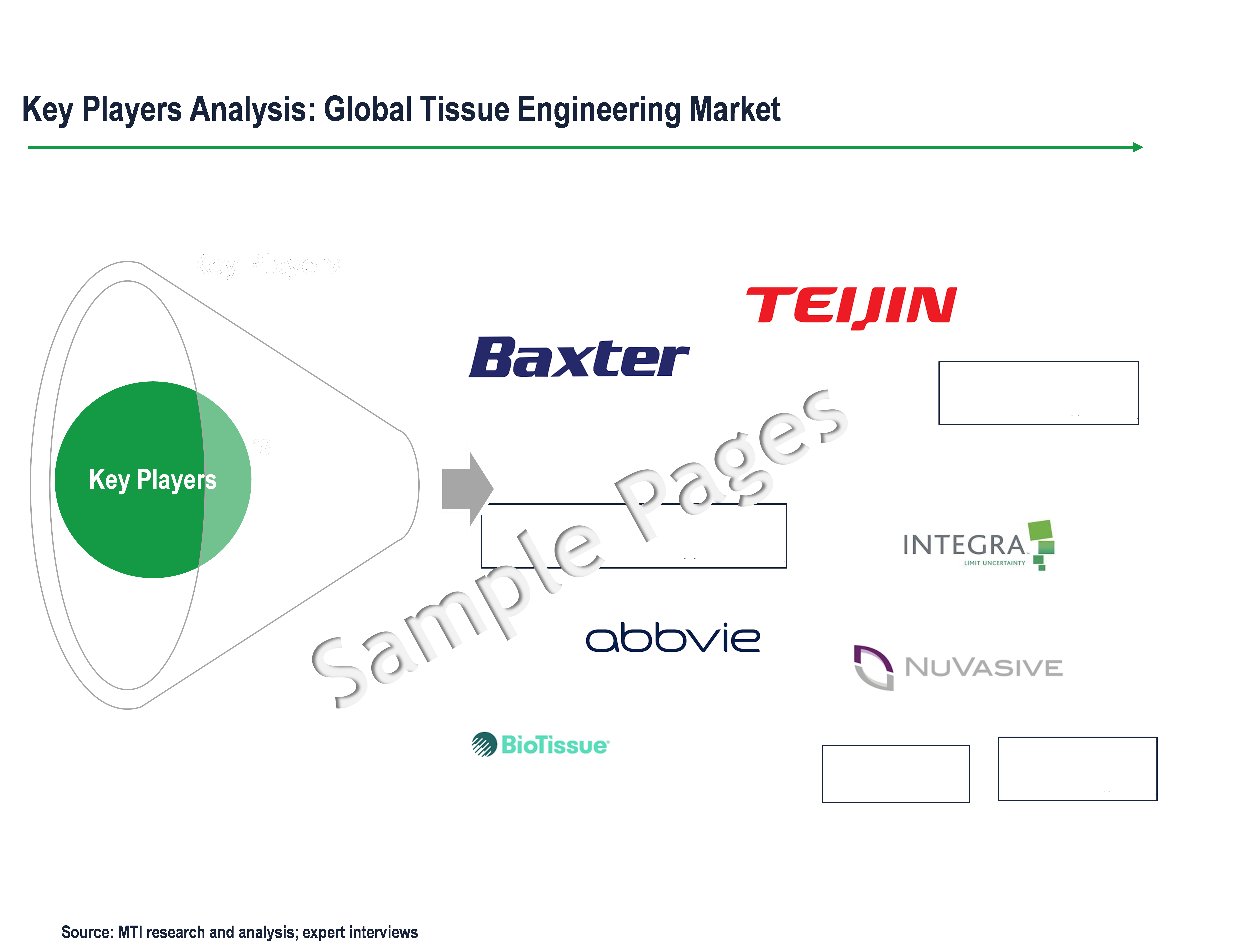
Get a sample report for competitive landscape analysis
Future Outlook of the Tissue Engineering Market
The global tissue engineering market is expected to gain further momentum in the coming years due to the growing research and application areas of tissue-engineered products, advancement in fabrication techniques such as 3D printing, availability of smart biomaterials, organ-on-chip technology, among others. These factors collectively contribute to the growth and evolution of the tissue engineering market.
Tissue Engineering Market Scope
|
Report Scope |
Details |
|
Base Year Considered |
2023 |
|
Historical Data |
2022 - 2023 |
|
Forecast Period |
2024 - 2029 |
|
Segment Scope |
Product, Application, End User |
|
Growth Rate |
CAGR 14-15% |
|
Regional Scope |
|
|
Key Companies Mapped |
ntegra LifeSciences Corporation, Medtronic, AbbVie, BioTissue, NuVasive, J&J Services, Organogenesis, Stryker, Terumo, Matricel (Nobel Biocare), Regrow Biosciences, Mallinckrodt Pharmaceuticals, Sumitomo Pharma, CollPlant Biotechnologies, Mimedx, Smith+Nephew, Cellular Logistics, Japan Tissue Engineering, Lattice Medical, Tissue Regenix, and Vericel Corporation among others |
|
Report Highlights |
Market Size & Forecast, Growth Drivers & Restraints, Trends, Competitive Analysis |
Key Strategic Questions Addressed
-
What is the market size & forecast for the Global Tissue Engineering Market?
-
What are the historical, present, and forecasted market shares and growth rates of various segments and sub-segments of the Global Tissue Engineering Market?
-
What are the major growth drivers, restraints/challenges impacting the market?
-
What are the opportunities prevailing in the market?
-
What is the investment landscape?
-
Which region has the highest share in the global market? Which region is expected to witness the highest growth rate in the next 5 years?
-
Who are the major players operating in the market? What is the competitive positioning of key players?
-
Who are the new players entering the market?
-
What are the key strategies adopted by players?
- Introduction
- Introduction
- Market Scope
- Market Definition
- Segments Covered
- Regional Segmentation
- Research Timeframe
- Currency Considered
- Study Limitations
- Stakeholders
- List of Abbreviations
- Key Conferences and Events (2024-2025)
- Research Methodology
- Secondary Research
- Primary Research
- Market Estimation
- Bottom-Up Approach
- Top-Down Approach
- Market Forecasting
- Executive Summary
- Tissue Engineering Market Snapshot (2023-2029)
- Segment Overview
- Regional Snapshot
- Competitive Insights
- Market Overview
- Market Dynamics
- Drivers
- Shortage of organ and tissue supply
- Rising incidence of degenerative bone diseases, diabetic ulcers, traumatic injuries, sports injuries, and chronic diseases
- Advancement in tissue engineering technologies
- Increasing demand for regenerative medicine
- Restraints
- Transition from clinical to commercial products/scalability challenges
- Regulatory challenges
- High cost
- Opportunities
- Emerging markets
- New application areas
- Key Market Trends
- 3D printing
- Organ-on-a chip
- Smart biomaterials
- Unmet Market Needs
- Industry Speaks
- Drivers
- Market Dynamics
- Global Tissue Engineering Market Size & Forecast (2022-2029), By Product & Service, USD Million
- Introduction
- Scaffolds
- Natural
- Synthetic
- Cells
- Autologous
- Allogeneic
- Xenogeneic
- Others
- Global Tissue Engineering Market Size & Forecast (2022-2029), By Application, USD Million
- Introduction
- Orthopedic & Musculoskeletal
- Dermatology & Wound care
- Cardiovascular
- Neurology
- Others
- Global Tissue Engineering Market Size & Forecast (2022-2029), By End User, USD Million
- Introduction
- Hospitals
- Specialty Care Clinics
- Ambulatory Surgery Centers (ASCs)
- Others
- Global Tissue Engineering Market Size & Forecast (2022-2029), By Region, USD Million
- Introduction
- North America Tissue Engineering Market Size & Forecast (2022-2029), By Country, USD Million
- US
- Market Size & Forecast, By Product & Service (USD Million)
- Market Size & Forecast, By Application (USD Million)
- Market Size & Forecast, By End User (USD Million)
- Canada
- Market Size & Forecast, By Product & Service (USD Million)
- Market Size & Forecast, By Application (USD Million)
- Market Size & Forecast, By End User (USD Million)
- Europe Tissue Engineering Market Size & Forecast (2022-2029), By Country, USD Million
- UK
- Market Size & Forecast, By Product & Service (USD Million)
- Market Size & Forecast, By Application (USD Million)
- Market Size & Forecast, By End User (USD Million)
- Germany
- Market Size & Forecast, By Product & Service (USD Million)
- Market Size & Forecast, By Application (USD Million)
- Market Size & Forecast, By End User (USD Million)
- France
- Market Size & Forecast, By Product & Service (USD Million)
- Market Size & Forecast, By Application (USD Million)
- Market Size & Forecast, By End User (USD Million)
- Italy
- Market Size & Forecast, By Product & Service (USD Million)
- Market Size & Forecast, By Application (USD Million)
- Market Size & Forecast, By End User (USD Million)
- Spain
- Market Size & Forecast, By Product & Service (USD Million)
- Market Size & Forecast, By Application (USD Million)
- Market Size & Forecast, By End User (USD Million)
- Rest of Europe
- Market Size & Forecast, By Product & Service (USD Million)
- Market Size & Forecast, By Application (USD Million)
- Market Size & Forecast, By End User (USD Million)
- Asia Pacific (APAC) Tissue Engineering Market Size & Forecast (2022-2029), By Country, USD Million
- China
- Market Size & Forecast, By Product & Service (USD Million)
- Market Size & Forecast, By Application (USD Million)
- Market Size & Forecast, By End User (USD Million)
- Japan
- Market Size & Forecast, By Product & Service (USD Million)
- Market Size & Forecast, By Application (USD Million)
- Market Size & Forecast, By End User (USD Million)
- India
- Market Size & Forecast, By Product & Service (USD Million)
- Market Size & Forecast, By Application (USD Million)
- Market Size & Forecast, By End User (USD Million)
- Rest of Asia Pacific
- Market Size & Forecast, By Product & Service (USD Million)
- Market Size & Forecast, By Application (USD Million)
- Market Size & Forecast, By End User (USD Million)
- Latin America (LATAM) Tissue Engineering Market Size & Forecast (2022-2029), USD Million
- Market Size & Forecast, By Product & Service (USD Million)
- Market Size & Forecast, By Application (USD Million)
- Market Size & Forecast, By End User (USD Million)
- Middle East & Africa (MEA) Tissue Engineering Market Size & Forecast (2022-2029), USD Million
- Market Size & Forecast, By Product & Service (USD Million)
- Market Size & Forecast, By Application (USD Million)
- Market Size & Forecast, By End User (USD Million)
- China
- UK
- US
- Competitive Landscape
- Key Players and their Competitive Positioning
- Competitive Positioning of Key Players (2023)
- Offerings Assessment, By Player
- Key Strategies Assessment, By Player (2022-2024)
- New Product & Service Launches
- Partnerships, Agreements, & Collaborations
- Mergers & Acquisitions
- Geographic Expansion
- Key Players and their Competitive Positioning
- Company Profiles*
(Business Overview, Financial Performance**, Products Offered, Recent Developments)
- Integra Lifesciences
- Baxter
- Mimedx Group
- Johnson & Johnson Services
- Medtronic
- Stryker
- Smith+Nephew
- NuVasive
- Teijin Ltd
- BD
- Organogenesis
- BioTissue
- Other Prominent Players
The study has been compiled based on extensive primary and secondary research.
Secondary Research (Indicative List)
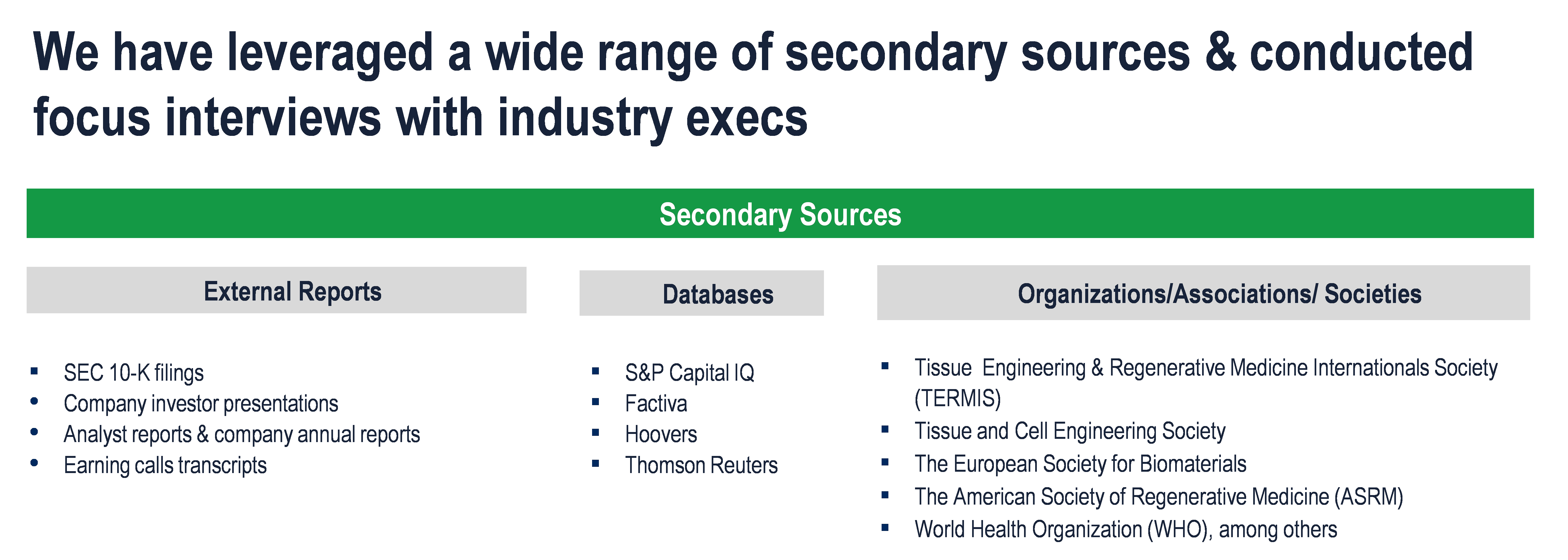
Primary Research
To validate research findings (market size & forecasts, market segmentation, market dynamics, competitive landscape, key industry trends, etc.), extensive primary interviews were conducted with both supply and demand-side stakeholders.
Supply Side Stakeholders:
- Senior Management Level: CEOs, Presidents, Vice-Presidents, Directors, Chief Technology Officers, Chief Commercial Officers
- Mid-Management Level: Product Managers, Sales Managers, Brand Managers, Business Development Managers, Consultants
Demand Side Stakeholders:
- Stakeholders in Hospitals, Ambulatory Surgery Centers, Specialty Care Clinics and Other End Users
Breakdown of Primary Interviews

Market Size Estimation
Both ‘Top-Down and Bottom-Up Approaches’ were used to derive market size estimates and forecasts.
Data Triangulation
Research findings derived through secondary sources & internal analysis were validated with Primary Interviews, Internal Knowledge Repository, and Company Sales Data.

